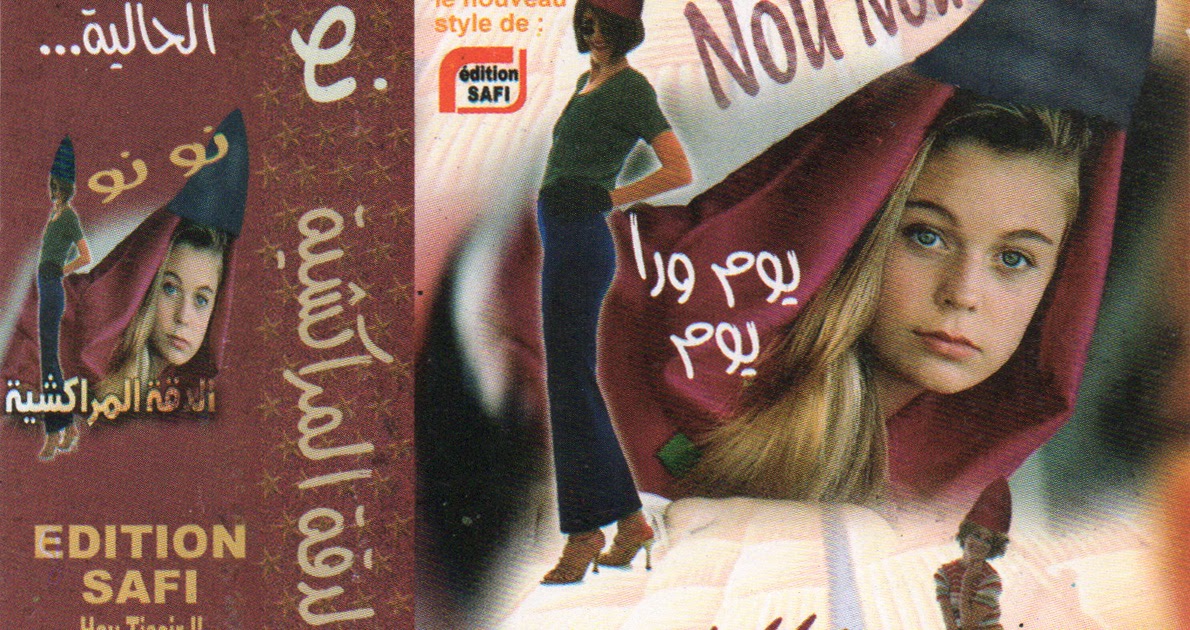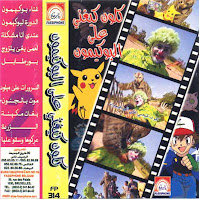
I’ve extolled the virtues of dqiqiya (a.k.a. tkitikate) men’s percussion and vocal groups in these pages before, most comprehensively in the post Tkitikate! Tkitikate! Party Time! Excellent!. I went as far as to posit the genre as “an active repository of Moroccan musical memory… like a jukebox”.
To be clear, I meant to say that A GOOD, LIVE DQIQIYA GROUP functions like that.
 On the other hand, there is a variety of commercial cassette that while exhibiting some sonic similarities to dqiqiya is primarily a cash-in on whatever is floating around in pop culture at the moment. This type of cassette does have the potential to be awesome, depending on how you feel about global pop hits, novelty tunes, and theme songs to TV programs. A prime example of this is the unforgettable Clown Sings About Pokémon cassette I shared here many moons ago.
On the other hand, there is a variety of commercial cassette that while exhibiting some sonic similarities to dqiqiya is primarily a cash-in on whatever is floating around in pop culture at the moment. This type of cassette does have the potential to be awesome, depending on how you feel about global pop hits, novelty tunes, and theme songs to TV programs. A prime example of this is the unforgettable Clown Sings About Pokémon cassette I shared here many moons ago.
However, this sort of cassette should not be taken as representative of the genre of dqiqiya. And it CERTAINLY should not be taken as representing the genre of Daqqa Marrakchia. (For my explication of the confusion between Daqqa Marrakchia and Dqiqiyya, see my post Ashura in Marrakech – Daqqa Marrakchiya.)
All of this is a preface to talking about today’s offering a 2003 cassette credited to a group called Dakka El Marrakechia Nou Nou. It is not a recording of the folkloric genre of Daqqa Marrakchiya, and it is not a recording of a standard dqiqiya group. It is a studio creation with some of the sonic trappings of dqiqiya, presenting itself with the name Daqqa Marrakchiya, and trying to have some fun (and cash in) on the latest pop culture trends.
For full disclosure, I had to shed a lot of baggage before writing about this novelty cassette because it pushed so many of my musical and musicological buttons. Here’s what I scribbled down while I was listening to the tape:
- I know I should get over it, but it bugs me that men’s percussion and vocal ensembles, more properly known as tkitikate or dqiqiya, are typically sold under the name of Dakka Marrakchiya.
- Real tkitikate keep the groove going and the crowd interested by using actual songs with actual lyrics, not by inserting singalong soccer-type chant melodies with no lyrics – that just seems lazy to me. . [egad, the blogger as arbiter of tkitikate authenticity 🤦🏻♂️]
- God, who thought that a synth bass and a little keyboard flute would be a good thing with this music. It’s already defanged from having much bite by the boring drum machine replacing real drums. [note: the blogger identifies as a bass player and is particularly allergic to synth basses and drum machines from actual gigging]
- The
backup vocals are too smooth. I mean, I really need to shut up. What do
I expect from commercial chaabi from Casablanca trying to brand itself
as dakka marrakchia. - Why the f— would you do this sort of
music with a drum machine and not with real drums. Again, I am a f—ing
hypocrite, ‘cos I DO LIKE drum machines if they’re AS IN YOUR FACE AS
ACTUAL DRUMS. I mean this sounds like the beats you’d put to some of
that smooth casablanca chaabi, which sort of works when your lead
instrument is a scratchy viola. BUT WHEN YOUR MAIN INSTRUMENT IS THE
DRUMS, WHY NOT MAKE THE DRUMS DRIVE THE GROOVE INSTEAD OF REMAINING
EXACTLY THE SAME THROUGHOUT THE ENTIRE TRACK.
Wow, so much vitriol for a harmless novelty cassette. Once I calmed down, I was able to enjoy it on its own flawed terms as a fun chaabi-rhythm time capsule of pop culture items that were “viral” in 2003 (before we were using the term viral). Here’s some of what you get:
The album is named Youm Wara Youm, a reference to the SMASH 2002 HIT of the same name by Samira Said with Cheb Mami.
I still ADORE that song:
The Dakka el Marrakchia Nou Nou song is nothing close to being a cover version of Youm Wara Youm. It does retain the lyrics
Youm wara youm
Habibi ma gani noum
Habibi wa dini git
But it’s not sung in anything similar to the melody of the original.
Track 2 appears to be based on the theme song to a Moroccan TV program from 2002, Dar Mwi Hniya (Mwi Hniya’s House)
There are some entertaining verses where the singer is hurling curses at his cell phone for dropping the signal while he’s talking to his sweetheart. And there’s a silly solfege singalong.
And the final track seems to be based on the Egyptian novelty song from 2002 “Baba Fein”, here called by the recurring lyric “Âmmu Âmmu”
If you’re in the mood for it, it’s sort of entertaining in the way that the original was, that is, it’s cute to hear kids delivering clever rhyming couplets making excuses to the Uncle (Âmmu) about why their father isn’t at home.
 |
| Si Mohamed Aguir (right) wearing a taguia |
One thing I can’t figure out, though, is the cover art for the album. What are the cone-shaped things superimposed on top of these ladies’ heads? Are they supposed to resemble the taguia hats worn by actual tqitikate groups? Nobody I showed this to has any idea what is going on. The general consensus is that it’s tkharbiqa (great Moroccan term meaning something like “nonsense”, “junk” or “whatever”)
Best Wishes to all for a better 2024. Ceasefire Now.
Dakka El Marrakechia Nou Nou الدقة المراكشية نو نو
Youm Wara Youm يعم ورا يوم
Edition Safi cassette SD 2003 انتاج الصافي
A1 Youm Wara Youm يعم ورا يوم
and the best current songs وأروع الأغاني الحالية
B1 Mwi Hniya مي هنية
B2 Âmmu Âmmu عمو عمو
Discover more from reviewer4you.com
Subscribe to get the latest posts to your email.






